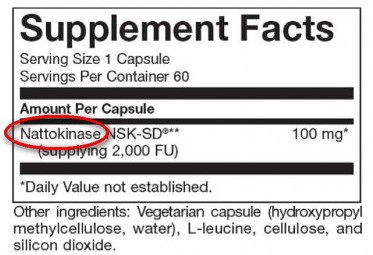


While blood clotting is an important process to prevent excessive bleeding when a blood vessel is injured, formation of blood clots within blood vessels without apparent injury can lead to a heart attack or stroke that can be fatal. As such, medications that help to prevent blood clotting, such as aspirin and warfarin, are prescribed to cardiovascular disease patients as a preventive measure. Nattokinase is considered to be a safe, low cost, and powerful natural substitute for these synthetic anti-clotting and blood thinning drugs [4]. For this reason, commercial nattokinase products are now widely as food supplements to improve blood flow and cardiovascular health.


In summary, natto is a superfood packed with essential nutrients and health benefits for the heart, blood, bone, and skin. If you never tasted it, give it a try today.
References
[1] W. Shurtleff, A. Aoyagi, History of Natto and its relatives, Soyinfo Center, Lafayette, CA, USA, 2012.
[2] B. Bayley, Why Japan’s ancient natto could be a key to a healthy life : SBS Food, SBS Website. (2017). http://www.sbs.com.au/food/article/2017/03/30/why-japans-ancient-natto-could-be-key-healthy-life (accessed September 6, 2017).
[3] C. Nagata, K. Wada, T. Tamura, K. Konishi, Y. Goto, S. Koda, T. Kawachi, M. Tsuji, K. Nakamura, Dietary soy and natto intake and cardiovascular disease mortality in Japanese adults: the Takayama study, Am. J. Clin. Nutr. 105 (2017) 426–431. doi:10.3945/ajcn.116.137281.
[4] Y. Weng, J. Yao, S. Sparks, K.Y. Wang, Nattokinase: An Oral Antithrombotic Agent for the Prevention of Cardiovascular Disease., Int. J. Mol. Sci. 18 (2017). doi:10.3390/ijms18030523.
[5] A. Taniguchi-Fukatsu, H. Yamanaka-Okumura, Y. Naniwa-Kuroki, Y. Nishida, H. Yamamoto, Y. Taketani, E. Takeda, Natto and viscous vegetables in a Japanese-style breakfast improved insulin sensitivity, lipid metabolism and oxidative stress in overweight subjects with impaired glucose tolerance, Br. J. Nutr. 107 (2012) 1184–1191. doi:10.1017/S0007114511004156.
[6] H. Katsuyama, S. Ideguchi, M. Fukunaga, K. Saijoh, S. Sunami, Usual dietary intake of fermented soybeans (Natto) is associated with bone mineral density in premenopausal women., J. Nutr. Sci. Vitaminol. (Tokyo). 48 (2002) 207–15.
[7] Y. Ikeda, M. Iki, A. Morita, E. Kajita, S. Kagamimori, Y. Kagawa, H. Yoneshima, Intake of fermented soybeans, natto, is associated with reduced bone loss in postmenopausal women: Japanese Population-Based Osteoporosis (JPOS) Study., J. Nutr. 136 (2006) 1323–8.
[8] N. Ozawa, N. Shimojo, Y. Suzuki, S. Ochiai, T. Nakano, Y. Morita, Y. Inoue, T. Arima, S. Suzuki, Y. Kohno, Maternal Intake of Natto, a Japan’s Traditional Fermented Soybean Food, during Pregnancy and the Risk of Eczema in Japanese Babies, Allergol. Int. 63 (2014) 261–266. doi:10.2332/allergolint.13-OA-0613.